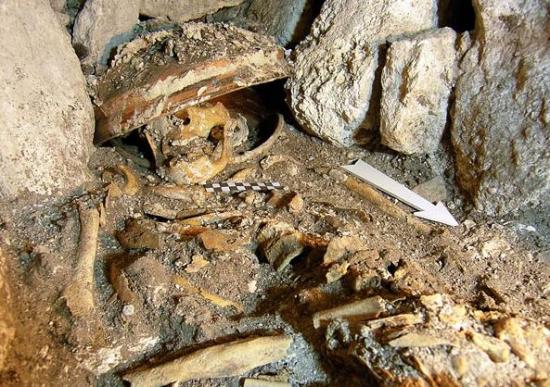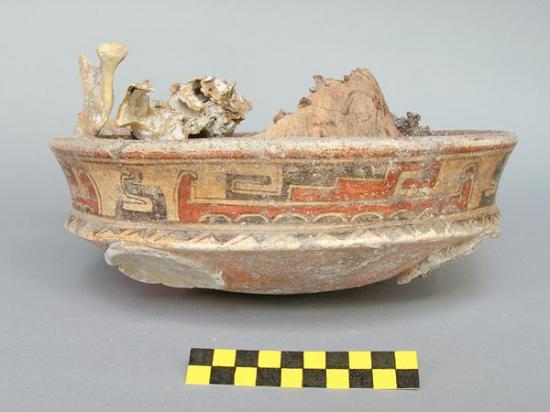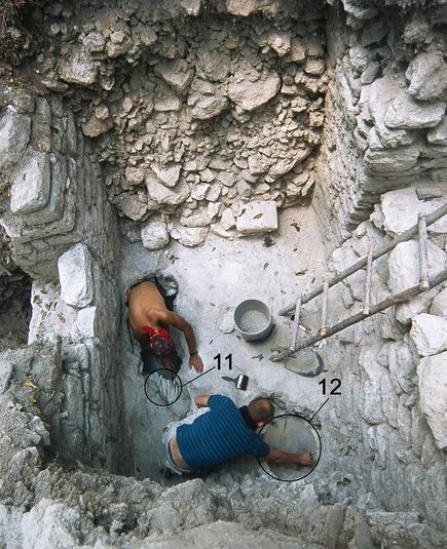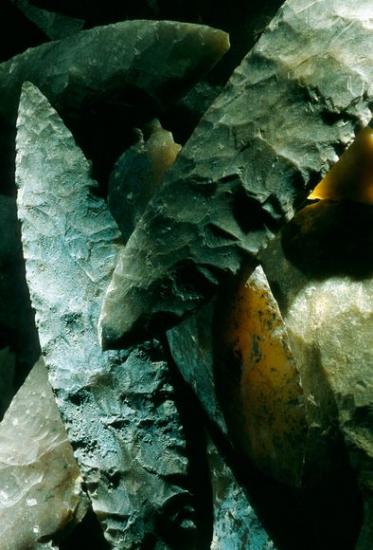Maya Royal Burial
Rachel Kaufman / Photograph courtesy Wiesław Koszkul, Nakum Archaeological Project
Source - http://news.nationalgeographic.com/news/2011/09/pictures/110922-rare-mayan-female-ruler-tomb-found-guatemala/?now=2011-09-22-00:01
A woman ruler's skeleton—her head mysteriously placed between two bowls—is one of two royal burials recently found at the Maya ruins of Nakum in Guatemala.

The roughly 2,000-year-old tomb was found underneath another, 1,300-year-old tomb filled with treasures such as jade gorgets—normally used to protect the throat—beads, and ceremonial knives.
The upper tomb's corpse had been badly destroyed by rodents within the last few centuries, but the body was clearly that of another Maya ruler-perhaps another female, based on the small size of a ring found in that tomb.
The royal burials are the first discovered in Nakum, once a densely packed Maya center. Study co-author Wiesław Koszkul and colleagues have been investigating Nakum's surroundings, known as the Cultural Triangle, for decades
"We think this structure was something like a mausoleum for the royal lineage for at least 400 years," said Koszkul, of the Jagiellonian University Institute of Archaeology in Krakow, Poland.
The Maya royal-tomb discoveries are described in the September issue of the journal Antiquity.

Archaeologists descend into Nakum's pyramid, formally known as Structure 15, in an undated picture.
The ancient structure had been completely overtaken by jungle growth before excavations began in 2006, and only a small hill covered in soil and vegetation hinted at its existence.
The hill and a neighboring mound called Structure 14 are located on the east side of a Nakum patio.
"Because the Maya believed the east is very important, since 2003 I have had a hypothesis that ... if there is a royal tomb in Nakum, it should be located in this structure," Koszkul said.
Once inside the first level of the tomb, the scientists noticed cracks in the floor. When they cut through the floor, they found the second, older crypt.
"I think we could find some more burials beneath the level we excavated, [but] our excavations—our test pits—are very narrow," Koszkul said. "We can't excavate everything."

The head of the dead woman found in the 2,000-year-old tomb was covered by a vessel, which is pictured above containing fragments of her skull.
The scientists don't know exactly why the body was buried with bowls, "but we have seen similar patterns in Tikal," a site also in Guatemala that was one of the most powerful pre-Columbian Maya cities, Koszkul said.
The royal figure's gender also took the researchers by surprise, he added.
"It's surprising to me—we were expecting a male," Koszkul said. While other nearby cities had turned up some evidence of female rulers, Maya queens were uncommon compared to kings, he explained.

Archaeologists excavate the upper level of the Structure 15 pyramid in a picture taken in 2008.
The researchers know the person buried inside this tomb was of high status: Not only was the body accompanied by a number of treasures, but the offerings continued for two centuries after the burial.
"What was really amazing was that the tomb was unlooted, despite the fact that we found looters' trenches around the side of Structure 15," said Nakum project director Jaroslaw Zralka.
Circle 11 in this photograph contained limestone bars, perhaps used to make fishing nets, while Circle 12 contained clay cooking plates and blue-painted knives, probably used for ritual offerings.

Nine flint knives dating to the Late Classic period (A.D. 600 to 700) were excavated from the upper royal burial.
At least four of the knives were painted with a blue pigment-the same color the Maya would paint victims before they were sacrificed, hinting that the knives were also used for ritual killings.
PART.2